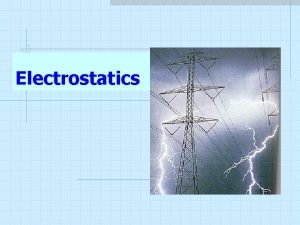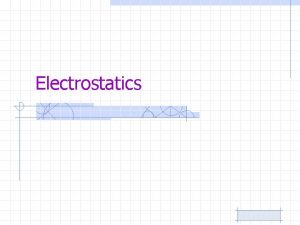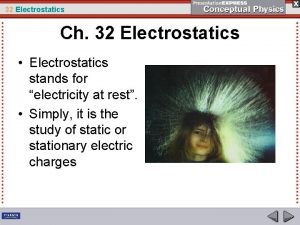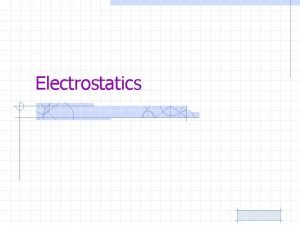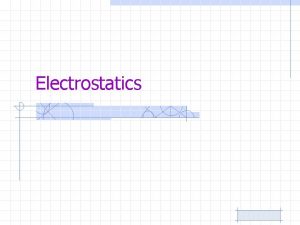ELECTROSTATICS II Electric Field 1 Electric Lines of







- Slides: 7

ELECTROSTATICS - II : Electric Field 1. Electric Lines of Force i) Due to a Point Charge ii) Due to a Dipole iii) Due to a Equal and Like Charges iv) Due to a Uniform Field 6. Properties of Electric Lines of Force 7. Electric Dipole 8. Electric Field Intensity due to an Electric Dipole 9. Torque on an Electric Dipole 10. Work Done on an Electric Dipole

Electric Lines of Force: An electric line of force is an imaginary straight or curved path along which a unit positive charge is supposed to move when free to do so in an electric field. Electric lines of force do not physically exist but they represent real situations. E E Electric Lines of Force

1. Electric Lines of Force due to a Point Charge: a) Representation of electric field in terms of field vectors: The size of the arrow represents the strength of electric field. q>0 q<0 b) Representation of electric field in terms of field lines (Easy way of drawing)

2. Electric Lines of Force due to a 3. Electric Lines of Force due to a pair of Equal and Unlike Charges: pair of Equal and Like Charges: (Dipole) +q +q P E . N +q -q Electric lines of force contract lengthwise to represent attraction between two unlike charges. Electric lines of force exert lateral (sideways) pressure to represent repulsion between two like charges.

4. Electric Lines of Force due to a Uniform Field: Properties of Electric Lines of Force or Field Lines: E - + + +1 C 1. The electric lines of force are imaginary lines. 2. A unit positive charge placed in the electric field tends to follow a path along the field line if it is free to do so. 3. The electric lines of force emanate from a positive charge and terminate on a negative charge. . 4. The tangent to an electric field line at any point gives the direction of the electric field at that point. 5. Two electric lines of force can never cross each other. If they do, then at the point of intersection, there will be two tangents. It means there are two values of the electric field at that point, which is not possible. Further, electric field being a vector quantity, there can be only one resultant field at the given point, represented by one tangent at the given point for the given line of force. E P E 1 S S O E L IB E N P T O E 2

6. Electric lines of force are closer (crowded) where the electric field is stronger and the lines spread out where the electric field is weaker. 7. Electric lines of force are perpendicular to the surface of a positively or negatively charged body. Q q Q > q 8. Electric lines of force contract lengthwise to represent attraction between two unlike charges. 9. Electric lines of force exert lateral (sideways) pressure to represent repulsion between two like charges.

10. The number of lines per unit cross – sectional area perpendicular to the field lines (i. e. density of lines of force) is directly proportional to the magnitude of the intensity of electric field in that region. ∆N ∆A α E 11. Electric lines of force do not pass through a conductor. Hence, the interior of the conductor is free from the influence of the electric field. + + + + E E - Solid or hollow + + conductor + No Field + - (Electrostatic Shielding) 12. Electric lines of force can pass through an insulator.








